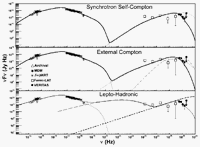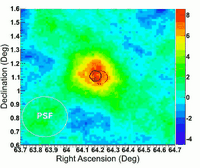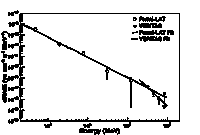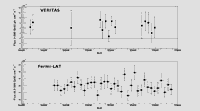
Reference: E. Aliu et al. (The VERITAS Collaboration), Astrophysical Journal 755: 118, 2012
Full text version
ArXiv: ArXiV:1206.4080
Contacts: Andrew Smith
One of the more remarkable accomplishments of the recent generation of gamma-ray instruments, such as VERITAS, has been the detection of increasingly distant active galactic nuclei (AGN) at TeV energies. While the previous generation of imaging atmospheric Cherenkov telescopes (IACTs) were able to detect AGN at redshifts of ~z=0.1, modern day IACTs are now consistently detecting new AGN at redshifts of 0.3 with possible detections reaching out as far as z=0.5.
The AGN 1ES 0414+009 is such an object, lying at a redshift of z~0.29. This AGN has been detected as a very bright X-ray source with luminosities comparable to more well studied TeV AGN such as Mrk 421 and PKS 2155-304. From 2008-2011, VERITAS observed 1ES 0414+009 for approximately 56 hours detecting the source at a statistical significance of 6.5 standard deviations above the background. Along with these observations, multiwavelength observations were carried out on 1ES 0414+009 in a broad range of radiative wavelengths including optical observations with the MDM observatory, hard X-ray coverage with Swift-XRT, and GeV gamma-ray observations with Fermi-LAT.
These multiwavelength observations were used to construct a spectral energy distirbution (SED) of the source, which can be used to test models of emission in the AGN. While the more commonly used models to explain emission from TeV AGN utilize a purely leptonic population of accelerated particles, the SED constructed from VERITAS multiwavelength observations appear to indicate that a hadronic component to the class of jet-accelerated particles within 1ES 0414+009 may be necessary. Further observations with VERITAS are underway (as well as observations with multiwavelength partners) in order to increase the sensitivity of this measurement. These measurements will allow for more precise models of particle acceleration in AGN to be tested and further our understanding of the most distant TeV sources in the universe.
Figures from paper (click to get full size image):




